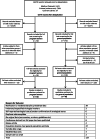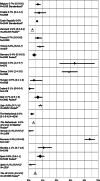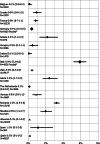Current prevalence of chronic hepatitis B and C virus infection in the general population, blood donors and pregnant women in the EU/EEA: a systematic review
- PMID: 28891457
- PMCID: PMC5647665
- DOI: 10.1017/S0950268817001947
Current prevalence of chronic hepatitis B and C virus infection in the general population, blood donors and pregnant women in the EU/EEA: a systematic review
Abstract
This systematic review aimed at estimating chronic hepatitis B (HBV) and C virus (HCV) prevalence in the European Union (EU) and Economic Area (EEA) countries in the general population, blood donors and pregnant women. We searched PubMed©, Embase© and Cochrane Library databases for reports on HBV and HCV prevalence in the general population and pregnant women in EU/EEA countries published between 2005 and 2015. Council of Europe data were used for HBV and HCV blood donor prevalence. HBV general population estimates were available for 13 countries, ranging from 0·1% to 4·4%. HCV general population estimates were available for 13 countries, ranging from 0·1% to 5·9%. Based on general population and blood donor estimates, the overall HBV prevalence in the EU/EEA is estimated to be 0·9% (95% CI 0·7-1·2), corresponding to almost 4·7 million HBsAg-positive cases; and the overall HCV prevalence to be 1·1% (95% CI 0·9-1·4), equalling 5·6 million anti-HCV-positive cases. We found wide variation in HCV and HBV prevalence across EU/EEA countries for which estimates were available, as well as variability between groups often considered a proxy for the general population. Prevalence estimates are essential to inform policymaking and public health practice. Comparing to other regions globally, HBV and HCV prevalence in the EU/EEA is low.
Keywords: Hepatitis B; hepatitis C; prevalence; systematic review.
Conflict of interest statement
None.
Figures




References
-
- EASL Clinical Practice Guidelines. Management of chronic hepatitis B virus infection. Journal of Hepatology 2012; 57: 167–185. - PubMed
-
- EASL Clinical Practice Guidelines. Management of hepatitis C virus infection. Journal of Hepatology 2014; 60: 392–420. - PubMed
-
- World Health Organization (http://www.who.int/mediacentre/factsheets/fs204_Jul2014/en/). Accessed June 2015.
-
- World Health Organization (http://www.who.int/mediacentre/factsheets/fs164/en/). Accessed June 2015.
-
- European Centre for Disease Prevention and Control. Surveillance and Prevention of Hepatitis B and C in Europe. Stockholm: ECDC, 2010.
Publication types
MeSH terms
LinkOut - more resources
Full Text Sources
Other Literature Sources

